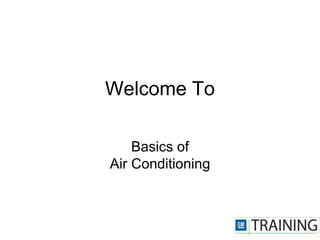
Ratheon AC Presentation
- 1. Welcome To Basics of Air Conditioning
- 2. Key components: o Refrigerant is the key element in any air conditioning system. hydrofluorocarbons (HFCs) HFC-134a HFC- 152a HFC-1234yf are the only EPA approved refrigerants for the automotive industry currently. At this time auto manufacturers are in the process of converting over to the non ozone depleting HFC- 1234yf from HFC-134a.
- 3. o The A/C compressor in most cases is belt driven and operates when the magnetic clutch is engaged. The compressor builds pressure on the vapor refrigerant. The refrigerant is discharged from the compressor through the condenser hose, and forced to flow to the condenser and then through the balance of the A/C system. The A/C system is mechanically protected with the use of a high pressure relief valve. If the high pressure switch were to fail or if the refrigerant system becomes restricted and the refrigerant pressure continued to rise, the high pressure relief valve will pop open and release refrigerant from the system.
- 4. o After leaving the compressor the refrigerant then enters the condenser in a high temperature, high pressure vapor state. As the refrigerant flows through the condenser, the heat of the refrigerant is transferred to the ambient air passing through the condenser. Cooling the refrigerant causes the refrigerant to condense and change from a vapor to a liquid state. o The condenser is located in front of the radiator for maximum heat transfer. The condenser is made of aluminum and aluminum cooling fins, which allows rapid heat transfer for the refrigerant. The semi-cooled liquid refrigerant exits the condenser and flows through the condenser tube, to the thermal expansion valve (TXV) or orifice depending on application. Receiver Drier
- 5. o A/C Accumulator vs. A/C Receiver-Drier o A vehicle A/C system has either an A/C accumulator or an A/C receiver-drier. Both parts function similarly, but there are also a couple of key differences that distinguish these two components. o Functions of the A/C Accumulator and Receiver-Drier o Both the A/C accumulator and the A/C receiver-drier are responsible for trapping moisture and debris as the refrigerant moves through the A/C system to ultimately generate cool air. To do this, each part has a desiccant bag that stores the unwanted moisture and debris. Further, both the A/C accumulator and the A/C receiver-drier store excess refrigerant liquid so that the liquid does not enter and damage the A/C compressor. These components are also responsible for controlling and monitoring the amount of refrigerant that enters the A/C evaporator. o Differences Between the A/C Accumulator and Receiver-Drier o With an A/C accumulator inside an orifice tube A/C system, an A/C receiver-drier lives within an A/C expansion valve system. The two parts cannot be interchanged. This is partly because the accumulator is considerably larger than the receiver-drier and designed to connect to the evaporator outlet in the low- pressure section of the orifice tube A/C system. On the other hand, the A/C receiver-drier is a smaller component designed to fit into the plumbing between the condenser outlet and the expansion valve inlet in the high-pressure section of the A/C system.
- 6. oRefrigerant exiting the thermal expansion valve flows into the evaporator core in a low pressure, liquid state. Ambient air is drawn through the HVAC case and passes through the evaporator core. Warm and moist air will cause the liquid refrigerant to boil inside of the evaporator core. The boiling refrigerant then absorbs heat from the ambient air and draws moisture onto the evaporator. The refrigerant exits the evaporator back through the thermal expansion valve and into the low side hose back to the compressor, in a vapor state completing the A/C cycle of heat removal. At the compressor, the refrigerant is compressed again and the cycle of heat removal is repeated. oThe conditioned air is distributed through the HVAC case for passenger comfort. The heat and moisture removed from the passenger compartment will also change form, or condense, and is discharged from the HVAC case as water under the vehicle.
- 8. The refrigerant changes to the following states throughout the complete AC cycle: • Hi pressure gas • Hi pressure liquid • Lo pressure liquid • Lo pressure gas
- 9. Questions?
